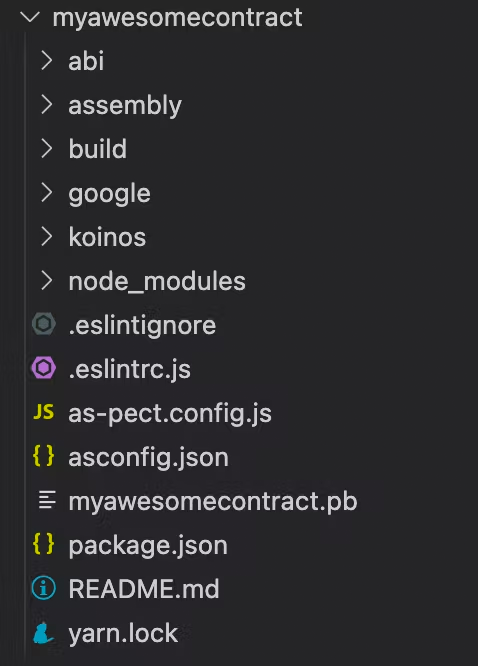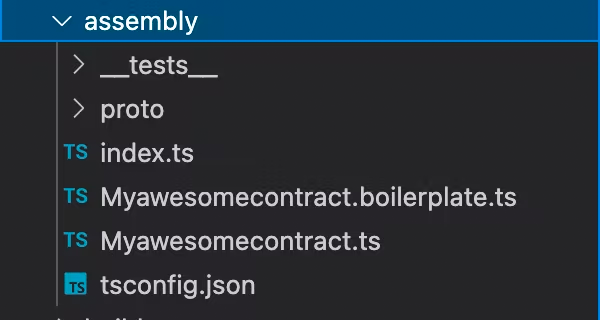Understanding the SDK Folder Structure
Lets explore the folder structure of our myawesomecontract project. It will be structured as follows:

The abi directory:
ABI stands for Application Binary Interface. The .abi file is automatically generated for you when building the contract however you do not need to upload it for your smart contract to work. Without the ABI file, it won't be possible for others to easily interact with your smart contract.
The assembly directory:
The vast majority of the development work will be focused in the assembly directory.

__tests__develop your unit tests in this directory.protodevelop your protobuf defintions in this directory.index.tscontains the logical entry point of the contract. It is generated for your automatically when building your contract.Myawesomecontract.boilerplate.tscontains the auto-generated boilerplate based on your proto file defintions. This file should be copied and the phrase.boilerplateshould be removed. The new file is where you will develop your production level code. Each time you build your contract, this file will be replaced so never code directly on this boiler plate file.Myawesomecontract.tsis created by the user (see above).tsconfig.jsontells the IDE what types are available in AssemblyScript, AS is like TypeScript but with WebAssembly types, it is automatically generated.
Let us now dig deeper into each of the two folders, __tests__ and proto.
The /assembly/__tests__ directory:
In __tests__ we should have a file called myawesomecontract.spec.ts containing unit tests for the smart contract. Unit tests are created by the developer.
Let's have a look at the actual unit test implementation for our Hello World contract. Comments have been added to the code that hasn't been explained previously:
// Import the smart contract ts file
import { Myawesomecontract } from '../Myawesomecontract';
// Import the proto ts file
import { myawesomecontract } from '../proto/myawesomecontract';
// Define a test suite
describe('contract', () => {
// Define a unit test
it("should return 'hello, NAME!'", () => {
// Create a new instance of the contract class
const c = new Myawesomecontract();
// Instantiate the arguments of the "hello" function
const args = new myawesomecontract.hello_arguments('World');
// Call the "hello" function
const res = c.hello(args);
// Check the result of the "hello" function is what is expected
expect(res.value).toStrictEqual('Hello, World!');
});
});The /assembly/proto directory:
The Koinos blockchain leverages Google's Protocol Buffers (Protobuf).
Protocol buffers are Google's language-neutral, platform-neutral, extensible mechanism for serializing structured data – think XML, but smaller, faster, and simpler.
The proto directory should look like this:

myawesomecontract.protocontains the protocol buffers definitions.myawesomecontract.tsis auto-generated AssemblyScript code based on the above proto file.
Let's have a look at myawesomecontract.proto for our Hello World contract:
syntax = "proto3";
package myawesomecontract;
// @description Says Hello!
// @read-only true
message hello_arguments {
string name = 1;
}
message hello_result {
string value = 1;
}We will focus on the important parts of this file:
package myawesomecontractis package name to which this proto file belongs, in this case, it's the name of the smart contract.message hello_argumentsis divided into 3 parts:messageindicates that we are declaring a new proto message.hellois the name of the smart contract function this message describes, in this casehello.argumentsdescribes the arguments of the function.
message hello_resultthe message that describes the result of the functionhello.
A smart contract function always contains an arguments and result message (even if the message is empty). Each arguments message can have the following commented annotations:
@descriptiondescribes what the function does.@read-onlyindicates is a read only function or not. Read only functions cannot write the blockchain database.
Inside each proto message are properties. In this case, string name = 1;, declares a property, name, of type, string, at field number, 1. For further information about the Protobuf definition language, you can read Google's Protobuf documentation.
Whenever the contents of the proto directory are changed, you will need to compile it again so that the new AS files get generated. To do this, run the following command:
yarn build:debugThis command will re-generate myawesomecontract.ts, index.ts, and myawesomecontract.boilerplate.ts.
The google directory:
This directory contains the dependencies related specifically google protobuf.
The koinos directory:
This directory contains the dependencies related specifically the koinos blockchain.
The build directory:
The build directory is created when running yarn build:release or yarn build:debug.
It has two sub directories, the debug and release. The /build/debug directory contains the smart contracts used for testing and is created when running yarn build:debug.
The /build/release directory contains the production smart contract .wasm file and is created when running yarn build:release. This .wasm file is ready to be uploaded to the Koinos Blockchain.
Final Notes
You should now understand the folder structure of the koinos-sdk-as-cli boiler plates made by the create command.